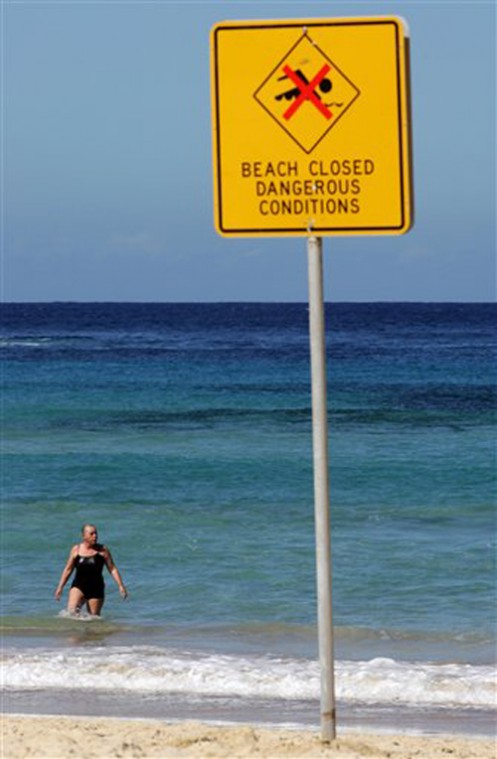Tsunami devastates western Solomon Islands
Apr 2, 2007
Last updated on May 12, 2016 at 09:15 a.m.
HONIARA, Solomon Islands (AP) – Tsunami waves churned by an undersea earthquake crashed ashore in the Solomon Islands on Monday, wiping away entire villages and triggering alerts from Australia to Hawaii, officials said. At least 13 people were killed, and the prime minister warned that the toll would likely grow.
In the South Pacific nation’s west, where the devastation appeared centered, there were reports of people being swept away as waves plowed up to a half-mile inland. The magnitude-8 quake that created the tsunami was followed by more than two dozen aftershocks, including at least four of magnitude-6 or stronger.
“It was just a noise like an underground explosion,” said Dorothy Parkinson, a resident of Gizo, where a wall of water swept through the streets. “The wave came almost instantaneously. Everything that was standing is flattened.”
Some residents described a wave up to 16 feet tall.
Get The Daily Illini in your inbox!
“We ran for our lives, away from the waves,” Arnold Pidakere, a schoolteacher in Gizo, told the British Broadcasting Corp. “When we looked back, we saw our house being destroyed.”
Pidakere was among thousands of residents of the town of 7,000 who fled to a nearby hill.
“There wasn’t any warning _ the warning was the earth tremors,” Alex Lokopio, premier of Western Province, told New Zealand’s National Radio. “It shook us very, very strongly and we were frightened, and all of a sudden the sea was rising up.”
Along the coast “all of the property was washed away to the open sea,” he said. At least three islands near Gizo also reported widespread destruction, although the number of people affected was unclear.
In a televised address, Prime Minister Manasseh Sogavare warned that the number of dead was likely to rise: “I think we are expecting more”.
“This is a very trying time for our nation and I would urge leaders at all levels in the affected areas to make it our utmost priority to ensure that our people receive the maximum comfort they need,” he said.
Julian Makaa, spokesman for the Solomons National Disaster Management Office, said extensive destruction was reported in the South Pacific nation’s west. But details remained sketchy because communications were reduced in many cases to scratchy two-way radio lines, and emergency officials struggled to reach outlying areas.
Alfred Maesulia, the information director in Prime Minister Manasseh Sogavare’s office, said late Monday that 13 people were killed and an unknown number remained missing.
“Some people were seen floating on the sea during the big waves but it was very difficult to go near them,” Maesulia told The Associated Press.
The magnitude-8 quake struck shortly after 7:39 a.m. six miles beneath the sea floor, about 215 miles northwest of the Solomons capital, Honiara, the U.S. Geological Survey said.
Within five minutes, waves 10-16 feet tall roared ashore and went up to half a mile inland, inundating buildings and sending thousands fleeing for higher ground, witnesses said.
The Pacific region went on high alert for several hours after the quake struck between the islands of Bougainville and New Georgia, with Sydney’s famous Bondi among beaches closed more than 1,250 miles away in Australia.
Warnings from the Hawaii-based Pacific Tsunami Warning Center were lifted within hours for areas outside the Solomons, but Australian officials closed beaches along the length of the country’s east coast, stopped ferry services in Sydney and warned fishing boats to return to port in precautionary measures that were lifted by the end of the day.
“We just feel it’s best to err on the side of caution,” said Warren Young, the chief lifeguard on Australia’s Gold Coast, about 1,370 miles from the quake’s epicenter.
In Gizo, the capital of Solomons’ Western Province, Judith Kennedy said water “right up to your head” swept through the town. Her father, dive shop owner Danny Kennedy, said the surge carried detritus.
“There are boats in the middle of the road, buildings have completely collapsed and fallen down,” he said by mobile phone as he toured Gizo.
Maesulia said residents of Simbo, Choiseul and Ranunga islands near Gizo also reported deaths and widespread destruction.
“There are reports that some villages were completely washed away,” he said. “Sasamungga village is quite a big village. … It was reported that 300 houses were completely destroyed in that village alone.”
Lokopio said up to 4,000 people who fled to a hill behind the town may need of emergency shelter and other supplies. He said most of the town’s government offices were badly damaged, along with police stations and at least one hospital.
Strong aftershocks continued throughout the day.
Solomon Islands deputy police commissioner Peter Marshall said three military helicopters would fly to the stricken region on Tuesday with supplies for the homeless. He said a national state of emergency has been declared.
The Solomon Islands is an impoverished archipelago of more than 200 islands northeast of Australia, with a population of about 552,000 people, that lies on the Pacific Basin’s so-called “Ring of Fire,” an arc of volcanos and fault lines where quakes frequently happen.
In 2004, a magnitude-9 quake sent tsunami waves slamming into the coastlines of a dozen countries around the Indian Ocean’s rim, killing about 230,000 people.






